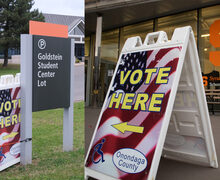SU Steam Station’s complicated relationship with a Syracuse neighborhood
Wendy Wang | Staff Photographer
David Rufus has experienced firsthand the effects that SU's Steam Station has had on the local community. In recent years, the station has made efforts to improve its relationship with the neighborhood.
Get the latest Syracuse news delivered right to your inbox.
Subscribe to our newsletter here.
Syracuse University’s Steam Station hasn’t always been a good neighbor, according to David Rufus.
Since 1926, SU’s Steam Station has towered over the corner of McBride and Taylor streets. Pioneer Homes, one of the oldest public housing communities in the U.S., is just across the street. The station borders Interstate 81, which destroyed and displaced a predominantly Black community when it was built in 1959 and continues to negatively affect residents today.
Rufus, the I-81 project coordinator for the New York Civil Liberties Union, believes the Steam Station — which provides heating to all buildings on SU’s Main Campus — has had as large an impact on his neighborhood as I-81.
“It has been the focal point of hurt, harm and danger for folks living in the community,” Rufus said.
SU’s Steam Station has contributed to pollution, disproportionately impacted Black residents and further depressed land value, according to a recent report from the NYCLU. Residents have also expressed concerns about the impact the Steam Station has on air quality and their health.
But throughout its nearly 100-year history, the Steam Station has made efforts to reduce its footprint in the community and give back to residents. Still, some residents have questions about the industrial facility looming over their neighborhood.
“A lot of people over there still don’t know what it actually is,” said Jameel Shareef, a 2014 SU graduate who grew up in Pioneer Homes. “It’s Syracuse University right in the heart of the neighborhood.”
Shareef remembers playing in Wilson Park across the street from the Steam Station, but neither he nor his friends knew exactly what went on there.

SU’s Steam Station is located on the corner of McBride and Taylor streets, across from Wilson Park and Pioneer Homes. Sarah Alessandrini | Asst. News Editor
The Steam Station also supplies heating to SUNY-ESF, the VA Medical Center, Crouse Hospital and SUNY Upstate Medical University. The station, which consists of two plants, also supplies cooling to 32 buildings on SU’s campus.
“I thought it was vacant for a lot of years when I was a kid,” Shareef said. “I didn’t think it was a working building.”
Shareef received SU’s Co-Generation Scholarship, which awards full tuition, fees, room and board to students living in the neighborhood surrounding the Steam Station.
Students living in the community bound by South Salina Street, East Castle Street, Renwick Avenue and East Adams Street are eligible to receive the scholarship, which was most recently awarded in 2018. The Syracuse Housing Authority works with SU to select recipients.
The university also works with city agencies and other community organizations to offer a Cogeneration Plant Grant Assistance Program, which provides a financial aid package to nearby residents who are pursuing a bachelor’s degree at SU.
The scholarship allowed Shareef to attend SU and even offered him the opportunity to work at the Steam Station during his summer and winter breaks.
“Without that building, I probably wouldn’t have gone to SU,” he said.
The Steam Station’s relationship with the neighborhood has improved in recent years, Rufus said. Many of the concerns residents have about the Steam Station now come from uncertainty about what it is or the effects it might have on the community, Shareef said.

SU’s Steam Station delivers steam to all buildings on SU’s Main Campus through six miles of underground piping. Sarah Alessandrini | Asst. News Editor
The utility company Project Orange operated the station from 1990 until about a decade ago, when SU broke ties with the company amid a series of lawsuits. In 2018, the university transferred operation of the station to Enwave Energy, a Canadian-based district energy services provider.
The station, which supplies steam through six miles of underground piping, allows SU more space within its buildings where heating or cooling equipment would otherwise go, said Nathan Prior, the station’s general manager.
The station has been burning natural gas since 1970 as residential development increased in the area, he said.
“A lot of colleges and universities in the last 10 years have started getting rid of coal,” Prior said. “We’re ahead of the curve because we got rid of it in 1970.”
While natural gas is cleaner than coal, the combustion still releases harmful pollutants. The main pollutants associated with natural gas combustion include carbon dioxide and nitrogen oxides, which concerns environmentalists because of their connection to climate change, said Huiting Mao, a professor of environmental chemistry at SUNY-ESF.
The station also emits volatile organic compounds, which are present in emissions from cars and tobacco smoke, and they can be carcinogenic, Mao said.
SU’s Steam Station emits 58.04 tons of nitrogen oxides and 9.703 tons of volatile organic compounds per year, the largest amount out of seven other facilities in Syracuse, according to data from the Environmental Protection Agency’s 2017 emissions reports on industrial facilities. The agency releases the reports every three years, most recently in 2017.
Since the station doesn’t burn coal, it emits less sulfur dioxide than some other facilities in the city, Mao said. It’s unlikely that current residents in the area would still be facing the effects of sulfur emissions from the station decades ago, she said.
“About this air pollution problem, it’s a very complex issue,” Mao said. “You really need to look at a wide range of chemical compounds, and they play different roles in different chemical reactions.”

Sarah Jimenez Miles | Design Editor
The NYCLU report found that children living near the station have disproportionately high rates of asthma, but it would take extensive research to determine if air pollution from the Steam Station or from I-81 is the main cause, Mao said.
Rydell Davis, who received the Co-Generation Scholarship and graduated from SU in 2013, said that he and most of his friends from the area had asthma growing up. When he moved out of the neighborhood, his asthma started to get better.
“In any event, higher levels of pollutants, higher levels of ozone, are definitely detrimental to human health, no doubt about that,” Mao said. “I cannot say with 100% confidence that they will cause high asthma rates in that area.”
The station’s operators have discussed ways to become more environmentally friendly, and many of those conversations are in line with changes being made at the state and federal level, Prior said. The station also holds a Title V Air Emissions Operating permit from the state, which limits how much and what kind of emissions the station can produce, Prior said.
Higher levels of pollutants, higher levels of ozone, are definitely detrimental to human health, no doubt about thatHuiting Mao, professor of environmental chemistry at SUNY-ESF
Employees are also trained on pesticides, as the station operates cooling towers with water that needs to be treated for bacteria and other chemicals, Prior said.
The station also conducts regular inspection of all its manholes. Since some of the station’s pipes run underground, its operators often have to shut down the street to conduct maintenance, Prior said.
Though the station has limited its environmental impact, some residents still have concerns, Rufus said. Sometimes the station creates disturbing noise, and the frequent construction on the street corner is inconvenient, he said.
Over the years, the Steam Station has built a relationship with the Syracuse Housing Authority, which it meets with regularly to discuss operations at the station, said Bill Simmons, executive director of the housing authority.
If residents have questions or concerns regarding the Steam Station, they can contact the housing authority for assistance, he said.
The Steam Station has taken on projects, including the repairment of a crumbling sidewalk on McBride Street, to help local residents, Prior said.
“We really pride ourselves on working with the neighborhood,” Prior said.

The steam station also supplies cooling to 32 SU buildings. The water at the cooling plant is treated for bacteria and other chemicals. Sarah Alessandrini | Asst. News Editor
Shareef and Davis were grateful to receive scholarships associated with the plant, but they wish the university would advertise the opportunities more. Shareef learned about the scholarship through a youth program he was involved in during high school. Davis learned about it through Rufus.
“It’s not advertised enough. A lot of people don’t know about it,” Shareef said. “I feel when more people know about it, they’ll go after it because it’s a great scholarship.”
SU had a big impact on Shareef’s life. But many children living in his neighborhood never get to see the university.
“In the area where I grew up, there are still kids down there, even though SU is less than a half-mile up the hill, who have never walked that grass or the sidewalks up there,” Shareef said.
Davis wants to see the university offer employment opportunities for people living in the immediate neighborhood. Shareef also wants to see educational opportunities for local high school students living in the area most directly affected by the Steam Station.
“Syracuse can still help with a lot,” Shareef said.
Published on April 29, 2021 at 12:13 am
Contact Sarah: scalessa@syr.edu | @sarahalessan






